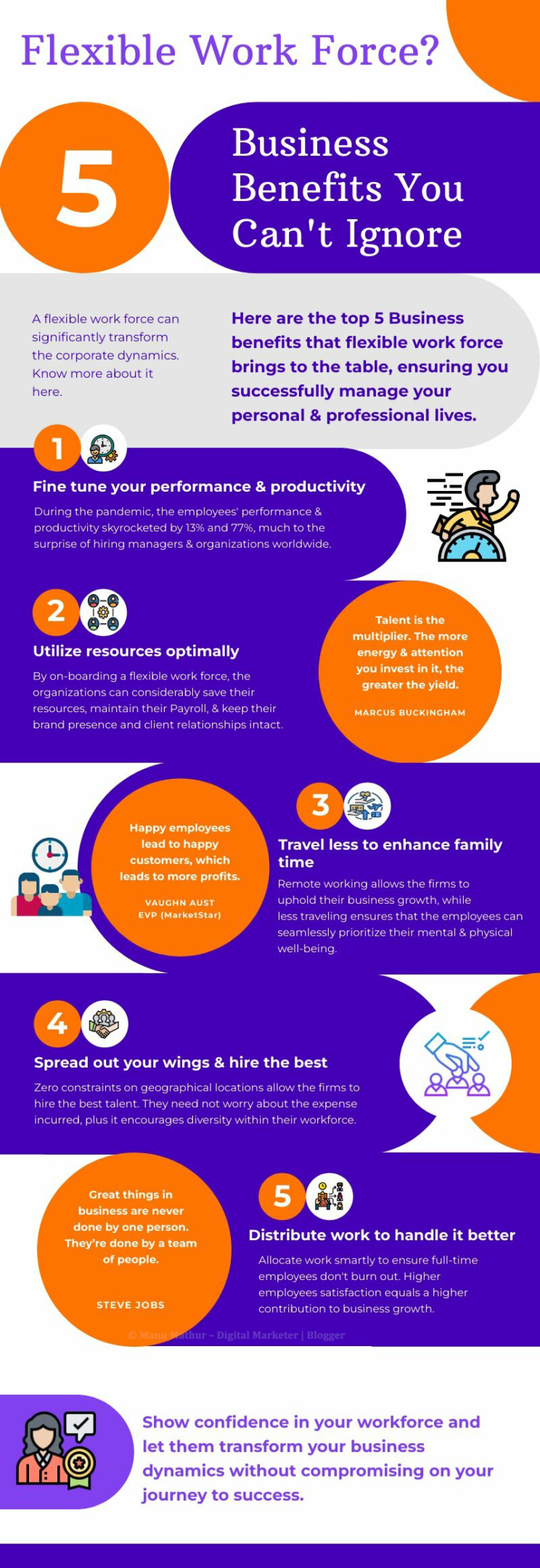The emergence of the COVID-19 pandemic in 2020 was a big surprise for corporations worldwide. The employers could not foresee how the work-from-home concept would pan out due to myriad factors. However, the companies soon realized that the emergence of a New Normal and remote work culture are staying for long. It even introduced the concept of a flexible work force & helped the corporations understand that work-life balance is the ultimate need of the hour.
Unprecedented changes in events made organizations implement flexible work policies allowing their workforce to manage work and family without hassle.
Considering that the threat of Covid-19 is still looming, this article discusses the top five benefits of a flexible work force & how companies benefit from it.
So, without further ado, let us begin:

Productivity & Performance Boost: 1st Significant Benefit of Flexible Work Force
When work-from-home began, the employers had a pre-conceived notion that the employees may slack and get lethargic. Instead, the employees showed a 13% increase in their performance and a 77% enhancement in productivity while working from home.
By adopting a remote culture and onboarding a flexible work force, the companies indirectly ensure that – employees have the freedom to pick their working hours & location to improve their retention power, be more creative & continuously evolve to ensure business growth.
Optimal Utilization of Resources: Do Not Ignore Checking Out This Pointer
By onboarding a flexible work force, the companies can optimize their resources and significantly cut down their operation & employment costs which a regular full-time employee requires. In addition, a flexible work force helps the organization maintain its Payroll and save more.
Additionally, businesses can minimize their overtime costs and ensure that the absence of full-time employees doesn’t hamper their business. It further helps them maintain their brand presence and client relationships.
Minimal to Negligible Travel: Time to Prioritize Physical & Mental Health
According to Economic Times 2019 statistics, nearly 7% of employees from the metro cities waste their time on their daily commute. This transit time impacts business growth and triggers unwarranted signs of stress, anxiety, and irritation in employees.
Thus, by leveraging a flexible work force, businesses give their employees time to prioritize their physical & mental well-being, avoid living a sedentary lifestyle, enhance their productivity & simultaneously make time for their loved ones.
A Wider Pool of Talent to Onboard / A Diversified Workforce: Hire The Best
It might surprise you, but organizations nearly spend $4,129 on average to train new hires. Hence, when the employees do not show up post-training, the companies have to again look for & recruit a unique talent that best matches their requirements.
To combat such issues, onboarding a flexible work force is the most viable option for the organization. It allows them to look for and hire talent without any geographical limitations, thus encouraging diversity. In addition, the workforce gets the flexibility to work from anywhere without disrupting the workflow of full-time employees.
Minimal Attrition: Start Valuing & Trusting Your Employees
“The greatest asset of a company is its people.”
– By Jorge Paulo Lemann
The above quote stands in this pandemic era, and businesses realize it. By recruiting a flexible work force, companies satisfy and reduce the work pressure off the shoulders of their full-time employees, minimizing attrition rate and employee turnover.
Further, this practice develops a sense of trust in their minds and encourages them to stick by their workplace through thick and thin. In addition, satisfied employees improve their performance, significantly contribute to business growth, and create a positive workplace.
What’s Your Take on Flexible Work Force?
The COVID-19 pandemic broke the shackles of traditional office setup and introduced employers to the concept of remote culture. It made them understand flexible workforce benefits, surpassing location barriers, and optimally utilizing their available resources.
Let us know what you think about the New Normal & the onboarding of the remote workforce. Share your thoughts on how this concept transformed the dynamics of your corporate firm through the comments section below.


